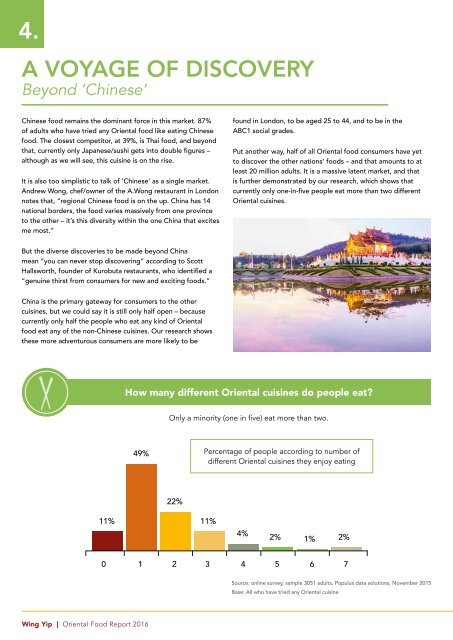ORIENTAL FOOD REPORT
1PLNVJy
1PLNVJy
Create successful ePaper yourself
Turn your PDF publications into a flip-book with our unique Google optimized e-Paper software.
4.<br />
A VOYAGE OF DISCOVERY<br />
Beyond ‘Chinese’<br />
Chinese food remains the dominant force in this market. 87%<br />
of adults who have tried any Oriental food like eating Chinese<br />
food. The closest competitor, at 39%, is Thai food, and beyond<br />
that, currently only Japanese/sushi gets into double figures –<br />
although as we will see, this cuisine is on the rise.<br />
It is also too simplistic to talk of ‘Chinese’ as a single market.<br />
Andrew Wong, chef/owner of the A.Wong restaurant in London<br />
notes that, “regional Chinese food is on the up. China has 14<br />
national borders, the food varies massively from one province<br />
to the other – it’s this diversity within the one China that excites<br />
me most.”<br />
found in London, to be aged 25 to 44, and to be in the<br />
ABC1 social grades.<br />
Put another way, half of all Oriental food consumers have yet<br />
to discover the other nations’ foods – and that amounts to at<br />
least 20 million adults. It is a massive latent market, and that<br />
is further demonstrated by our research, which shows that<br />
currently only one-in-five people eat more than two different<br />
Oriental cuisines.<br />
Thai food is the second most commonly eaten Oriental food,<br />
and it is liked by the great majority of those who eat<br />
the emerging cuisines, such as Vietnamese and Malaysian.<br />
In fact, early in 2015, Malaysian food was described by Mintel<br />
as a “rising star”, as well as being identified by Ken Hom as<br />
being at an “exciting” stage – probably where Thai was 10<br />
years ago.”<br />
In the Thai market “special mention should go to the<br />
branded Thai operators who really have challenged customer<br />
perceptions and brought a fresh approach to Thai food in a<br />
number of ways” according to Fine Food Capital’s Jon Lake,<br />
citing brands such as Thaikun, Busaba, Giggling Squid, Koh<br />
Thai and Rosa’s – “all quality brands bringing something<br />
different to the consumer.”<br />
Whilst there is no denying the buzz around Korean and<br />
Vietnamese food, particularly in London, currently these<br />
cuisines are consumed by only 5% and 7% of Oriental food<br />
users. However, there were signs of Korean food beginning<br />
to emerge in supermarkets and on mainstream pub menus<br />
in 2015.<br />
23<br />
Greater consumer access is likely to bring greater<br />
consumer uptake, and increasing restaurant<br />
numbers will do much to drive this trend.<br />
But the diverse discoveries to be made beyond China<br />
mean “you can never stop discovering” according to Scott<br />
Hallsworth, founder of Kurobuta restaurants, who identified a<br />
“genuine thirst from consumers for new and exciting foods.”<br />
China is the primary gateway for consumers to the other<br />
cuisines, but we could say it is still only half open – because<br />
currently only half the people who eat any kind of Oriental<br />
food eat any of the non-Chinese cuisines. Our research shows<br />
these more adventurous consumers are more likely to be<br />
How many different Oriental cuisines do people eat?<br />
Only a minority (one in five) eat more than two.<br />
49%<br />
Percentage of people according to number of<br />
different Oriental cuisines they enjoy eating<br />
22%<br />
11% 11%<br />
4%<br />
2% 1% 2%<br />
0 1 2 3 4 5 6 7<br />
Source: online survey, sample 3051 adults, Populus data solutions, November 2015<br />
Base: All who have tried any Oriental cuisine<br />
Wing Yip | Oriental Food Report 2016 Wing Yip | Oriental Food Report 2016


